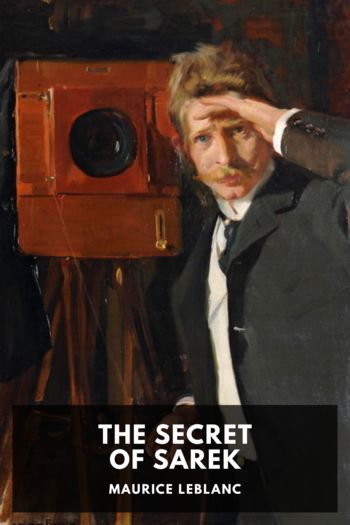The Secret of Sarek - Maurice Leblanc (easy to read books for adults list TXT) 📗

- Author: Maurice Leblanc
Book online «The Secret of Sarek - Maurice Leblanc (easy to read books for adults list TXT) 📗». Author Maurice Leblanc
“In my eyes it dominates the whole of the legendary and fabled past of Brittany. It is the radiating centre of all the superstitions, all the beliefs, all the fears and hopes of the country. By virtue of the stone or of the magic sceptre which the archdruid wielded and with which he burnt men’s flesh or healed their sores at will, we see the beautiful tales of romance springing spontaneously into being, tales of the knights of the Round Table, tales of Merlin the wizard. The stone is at the bottom of every mystery, at the heart of every symbol. It is darkness and light in one, the great riddle and the great explanation.”
Don Luis uttered these last words with a certain exaltation. He smiled:
“Don’t let yourself be carried away, Vorski. We’ll keep our enthusiasm for the narrative of your crimes. For the moment, we are at the climax of the Druidical period, a period which lasted far beyond the Druids through long centuries during which, after the Druids had gone, the miraculous stone was exploited by the sorcerers and soothsayers. And thus we come gradually to the third period, the religious period, that is to say, actually to the progressive decline of all that constituted the glory of Sarek: pilgrimages, commemorative festivals and so forth.
“The Church in fact was unable to put up with that crude fetish-worship. As soon as she was strong enough, she was bound to fight against the block of granite which attracted so many believers and perpetuated so hateful a religion. The fight was an unequal one; and the past succumbed. The dolmen was moved to where we stand, the slab of the kings of Bohemia was buried under a layer of earth and a Calvary rose at the very spot where the sacrilegious miracles were once wrought.
“And, over and above that, there was the great oblivion!
“Let me explain. The practices were forgotten. The rites were forgotten and all that constituted the history of a vanished cult. But the God-Stone was not forgotten. Men no longer knew where it was. In time they even no longer knew what it was. But they never ceased to speak of and believe in the existence of something which they called the God-Stone. From mouth to mouth, from generation to generation, they handed down on to one another fabulous and terrible stories, which became farther and farther removed from reality, which formed a more and more vague and, for that matter, a more and more frightful legend, but which kept alive in their imaginations the recollection of the God-Stone and, above all, its name.
“This persistence of an idea in men’s memories, this survival of a fact in the annals of a country had the logical result that, from time to time, some enquiring person would try to reconstruct the prodigious truth. Two of these enquiring persons, Brother Thomas, a member of the Benedictine Order, who lived in the middle of the fifteenth century, and the man Maguennoc, in our own time, played an important part. Brother Thomas was a poet and an illuminator about whom we possess not many details, a very bad poet, to judge by his verses, but as an illuminator ingenuous and not devoid of talent. He left a sort of missal in which he related his life at Sarek Abbey and drew the thirty dolmens of the island, the whole accompanied by instances, religious quotations and predictions after the manner of Nostradamus. It was this missal, discovered by Maguennoc aforesaid, that contained the famous page with the crucified women and the prophecy relating to Sarek; it was this missal that I myself found and consulted last night in Maguennoc’s bedroom.
“He was an odd person, this Maguennoc, a belated descendant of the sorcerers of old; and I strongly suspect him of playing the ghost on more than one occasion. You may be sure that the white-robed, white-bearded Druid whom people declared that they had seen on the sixth day of the moon, gathering the mistletoe, was none other than Maguennoc. He too knew all about the good old recipes, the healing herbs, the way to work up the soil so as to make it yield enormous flowers. One thing is certain, that he explored the mortuary crypts and the hall of the sacrifices, that it was he who purloined the magic stone contained in the knob of the sceptre and that he used to enter these crypts by the opening through which we have just come, in the middle of the Postern path, of which he was obliged each time to replace the screen of stones and pebbles. It was he also who gave M. d’Hergemont the page from the missal. Whether he confided the result of his last explorations to him and how much exactly M. d’Hergemont knew does not matter now. Another figure looms into sight, one who is henceforth the embodiment of the whole affair and claims all our attention, an emissary dispatched by fate to solve the riddle of the centuries, to carry out the orders of the mysterious powers and to pocket the God-Stone. I am speaking of





Comments (0)